India's Fiscal Deficit Reaches 36.5% of FY26 Target in H1, Driven by Capital Expenditure
Economy
|
1st November 2025, 4:33 AM

▶
Short Description :
Detailed Coverage :
Data released by the Controller General of Accounts (CGA) shows that India's fiscal deficit stood at ₹5,73,123 crore, or 36.5% of the full-year target, in the first six months of FY26 (April-September). This is a notable increase compared to 29% recorded in the first half of FY25.
A significant 40% spike in capital expenditure by the Government of India was the main driver behind the widening deficit. Conversely, the revenue deficit saw a substantial reduction, shrinking to ₹27,147 crore from ₹74,155 crore in H1FY25. This improvement occurred despite a modest 1.5% rise in revenue expenditure.
Revenue generation was bolstered by a 30.5% surge in non-tax revenues. However, net tax revenues contracted by 2.8%. Aditi Nayar, chief economist at Icra, noted that the contraction in net tax revenue was due to muted growth in gross tax revenues and a sharp uptick in the devolution of taxes to the states. She expressed apprehension that taxes might undershoot the budgeted target, requiring over 21% growth in the second half of FY26 to meet the budget estimates.
Impact: This news indicates increased government spending on infrastructure development, which is positive for long-term economic growth. However, a higher fiscal deficit means increased government borrowing. If this trend continues, it could put upward pressure on interest rates, making borrowing more expensive for businesses and potentially affecting investment. The government's focus on capital expenditure is a sign of its commitment to building national assets. Impact Rating: 7/10
Difficult Terms Explained: Fiscal Deficit: The gap between the government's total expenditure and its total revenue, excluding borrowings. It represents how much money the government needs to borrow. Capital Expenditure (Capex): Spending by the government on acquiring or creating long-term assets, such as infrastructure projects (roads, bridges, power plants), which are expected to provide economic benefits over many years. Revenue Deficit: The difference between the government's revenue receipts (like taxes) and its revenue expenditure (like salaries, interest payments, subsidies). It indicates how much the government is spending on its day-to-day functions that is not covered by its revenue. Revenue Expenditure: The expenses incurred by the government for its normal day-to-day operations, which do not result in the creation of assets. Examples include salaries, pensions, interest payments on debt, and subsidies. Non-Tax Revenues: Income earned by the government from sources other than taxes. This includes dividends from public sector undertakings, interest on loans, grants, and fees from services. Net Tax Revenues: The total amount of taxes collected by the central government after deducting the share transferred to the state governments as per the revenue sharing formula.